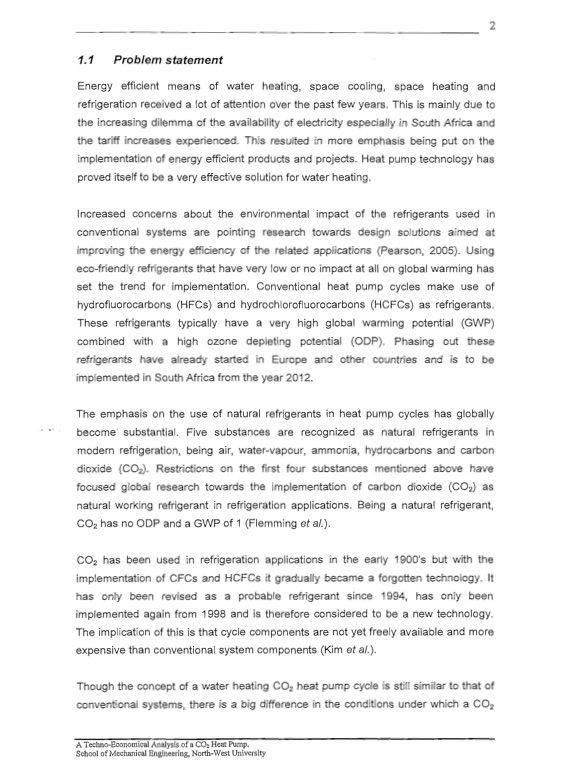
PDF Publication Title:
Text from PDF Page: 014
1.1 Problem statement Energy efficient means of water heating, space cooling, space heating and refrigeration received a lot of attention over the past few years. This is mainly due to the increasing dilemma of the availability of electricity especially in South Africa and the tariff increases experienced. This resulted in more emphasis being put on the implementation of energy efficient products and projects. Heat pump technology has proved itself to be a very effective solution for water heating. Increased concerns about the environmental impact of the refrigerants used in conventional systems are pointing research towards design solutions aimed at improving the energy efficiency of the related applications (Pearson, 2005). Using eco-friendly refrigerants that have very low or no impact at all on global warming has set the trend for implementation. Conventional heat pump cycles make use of hydrofluorocarbons (HFCs) and hydrochlorofluorocarbons (HCFCs) as refrigerants. These refrigerants typically have a very high global warming potential (GWP) combined with a high ozone depleting potential (ODP). Phasing out these refrigerants have already started in Europe and other countries and is to be implemented in South Africa from the year 2012. The emphasis on the use of natural refrigerants in heat pump cycles has globally become" substantial. Five substances are recognized as natural refrigerants in modern refrigeration, being air, water-vapour, ammonia, hydrocarbons and carbon dioxide (C02), Restrictions on the first four substances mentioned above have focused global research towards the implementation of carbon dioxide (C02) as natural working refrigerant in refrigeration applications. Being a natural refrigerant, CO2 has no ODP and a GWP of 1 (Flemming et 81.). CO2 has been used in refrigeration applications in the early 1900's but with the implementation of CFCs and HCFCs it gradually became a forgotten technology. It has only been revised as a probable refrigerant since 1994, has only been implemented again from 1998 and is therefore considered to be a new technology. The implication of this is that cycle components are not yet freely available and more expensive than conventional system components (Kim et 81.). Though the concept of a water heating CO2 heat pump cycle is still similar to that of conventional systems, there is a big difference in the conditions under which a CO2 A Techno-Economical Analysis of a CO2 Heat Pump. School ofMechanical Engineering, North-West University 2PDF Image | CO2 HEAT PUMP Analysis

PDF Search Title:
CO2 HEAT PUMP AnalysisOriginal File Name Searched:
co2-heat-pump-techno-analysis.pdfDIY PDF Search: Google It | Yahoo | Bing
CO2 Organic Rankine Cycle Experimenter Platform The supercritical CO2 phase change system is both a heat pump and organic rankine cycle which can be used for those purposes and as a supercritical extractor for advanced subcritical and supercritical extraction technology. Uses include producing nanoparticles, precious metal CO2 extraction, lithium battery recycling, and other applications... More Info
Heat Pumps CO2 ORC Heat Pump System Platform More Info
| CONTACT TEL: 608-238-6001 Email: greg@infinityturbine.com | RSS | AMP |